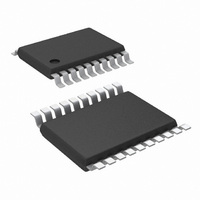LM26003MHX/NOPB National Semiconductor, LM26003MHX/NOPB Datasheet - Page 10

LM26003MHX/NOPB
Manufacturer Part Number
LM26003MHX/NOPB
Description
IC REG BUCK SW 3A 20-TSSOP
Manufacturer
National Semiconductor
Series
PowerWise®r
Type
Step-Down (Buck)r
Datasheet
1.LM26003QMHNOPB.pdf
(20 pages)
Specifications of LM26003MHX/NOPB
Internal Switch(s)
Yes
Synchronous Rectifier
No
Number Of Outputs
1
Voltage - Output
1.25 ~ 35 V
Current - Output
3A
Frequency - Switching
150kHz ~ 500kHz
Voltage - Input
4 ~ 38 V
Operating Temperature
-40°C ~ 125°C
Mounting Type
Surface Mount
Package / Case
20-TSSOP Exposed Pad, 20-eTSSOP, 20-HTSSOP
Power - Output
3.1W
Lead Free Status / RoHS Status
Lead free / RoHS Compliant
Other names
LM26003MHX
Available stocks
Company
Part Number
Manufacturer
Quantity
Price
Company:
Part Number:
LM26003MHX/NOPB
Manufacturer:
ST
Quantity:
445
Part Number:
LM26003MHX/NOPB
Manufacturer:
TI/德州仪器
Quantity:
20 000
www.national.com
supply current in sleep mode can be calculated based on the
wake duty cycle, as shown below:
Where I
I
And Io is the sum of Iload, Ibias, and current through the
feedback resistors.
Because this calculation applies only to sleep mode, use the
I
is connected to ground, use the same equation with Ibias
equal to zero and I
FPWM
Pulling the FPWM pin high disables sleep mode and forces
the LM26003 to always operate in PWM mode. Light load ef-
ficiency is reduced in PWM mode, but switching frequency
remains stable. The FPWM pin can be connected to the VDD
pin to pull it high. In FPWM mode, under light load conditions,
the regulator operates in discontinuous conduction mode
(DCM) . In discontinuous conduction mode, current through
the inductor starts at zero and ramps-up to its peak, then
ramps-down to zero again. Until the next cycle, the inductor
current remains at zero. At nominal load currents, in FPWM
mode, the device operates in continuous conduction mode,
where positive current always flows in the inductor. Typical
discontinuous operation waveforms are shown below.
At very light load, in FPWM mode, the LM26003 may enter
sleep mode. This is to prevent an over-voltage condition from
occurring. However, the FPWM sleep threshold is much lower
than in normal operation.
ENABLE
The LM26003 provides a shutdown function via the EN pin to
disable the device when the output voltage does not need to
be maintained. EN is an analog level input with typically 180
mV of hysteresis. The device is active when the EN pin is
above 1.18V (typical) and in shutdown mode when EN is be-
low this threshold. When EN goes high, the internal VDD
regulator turns on and charges the VDD capacitor. When
VDD reaches 3.9V (typical), the soft-start pin begins to source
current. In shutdown mode, the VDD regulator shuts down
and total quiescent current is reduced to 10.8 µA (typical).
Because the EN pin sources 4.85 µA (typical) of pull-up cur-
QG
q_Sleep_VB
= (9.2 x 10
FIGURE 4. Discontinuous Mode Waveforms
QG
and I
is the gate drive current, calculated as:
Iin = Iq + (I
-9
BIAS_SLEEP
) x f
75 mA Load, Vin = 12V
q_Sleep_VDD
SW
QG
values from the EC table. If VBIAS
x Dwake) + (Io x D)
.
30067608
10
rent, this pin can be left open for always-on operation. When
open, EN will be pulled up to VIN.
If EN is connected to VIN, it must be connected through a 10
kΩ resistor to limit noise spikes. EN can also be driven exter-
nally with a maximum voltage of 38V or VIN + 15V, whichever
is lower.
SOFT-START
The soft-start feature provides a controlled output voltage
ramp-up at startup. This reduces inrush current and elimi-
nates output overshoot at turn-on. The soft-start pin, SS, must
be connected to GND through a capacitor. At power-on, en-
able, or UVLO recovery, an internal 2.5 µA (typical) current
charges the soft-start capacitor. During soft-start, the error
amplifier output voltage is controlled by both the soft-start
voltage and the feedback loop. As the SS pin voltage ramps-
up, the duty-cycle increases proportional to the soft-start
ramp, causing the output voltage to ramp-up. The rate at
which the duty-cycle increases depends on the capacitance
of the soft-start capacitor. The higher the capacitance, the
slower the output voltage ramps-up. The soft-start capacitor
value can be calculated with the following equation:
Where tss is the desired soft-start time and Iss is the soft-start
source current. During soft-start, current limit and synchro-
nization remain in effect, while sleep mode and frequency
foldback are disabled. Soft-start mode ends when the SS pin
voltage reaches 1.23V typical. At this point, output voltage
control is transferred to the FB pin and the SS pin is dis-
charged.
CURRENT LIMIT
The peak current limit is set internally by directly measuring
peak inductor current through the internal switch. To ensure
accurate current sensing, AVIN should be bypassed with a
minimum 100 nF ceramic capacitor as close as possible to
AVIN and GND pins. Also the PVIN pin should be bypassed
with at least 2.2 µF to ensure low jitter operation.
When the inductor current reaches the current limit threshold,
the internal FET turns off immediately allowing inductor cur-
rent to ramp-down until the next cycle. This reduction in duty-
cycle corresponds to a reduction in output voltage.
The current limit comparator is disabled for less than 150 ns
at the leading edge for increased immunity to switching noise.
Because the current limit monitors peak inductor current, the
DC load current limit threshold varies with inductance and
frequency. Assuming a minimum current limit of 3.15A, max-
imum load current can be calculated as follows:
Where Iripple is the peak-to-peak inductor ripple current, cal-
culated as shown below:
To find the worst case (lowest) current limit threshold, use the
maximum input voltage and minimum current limit specifica-
tion.













